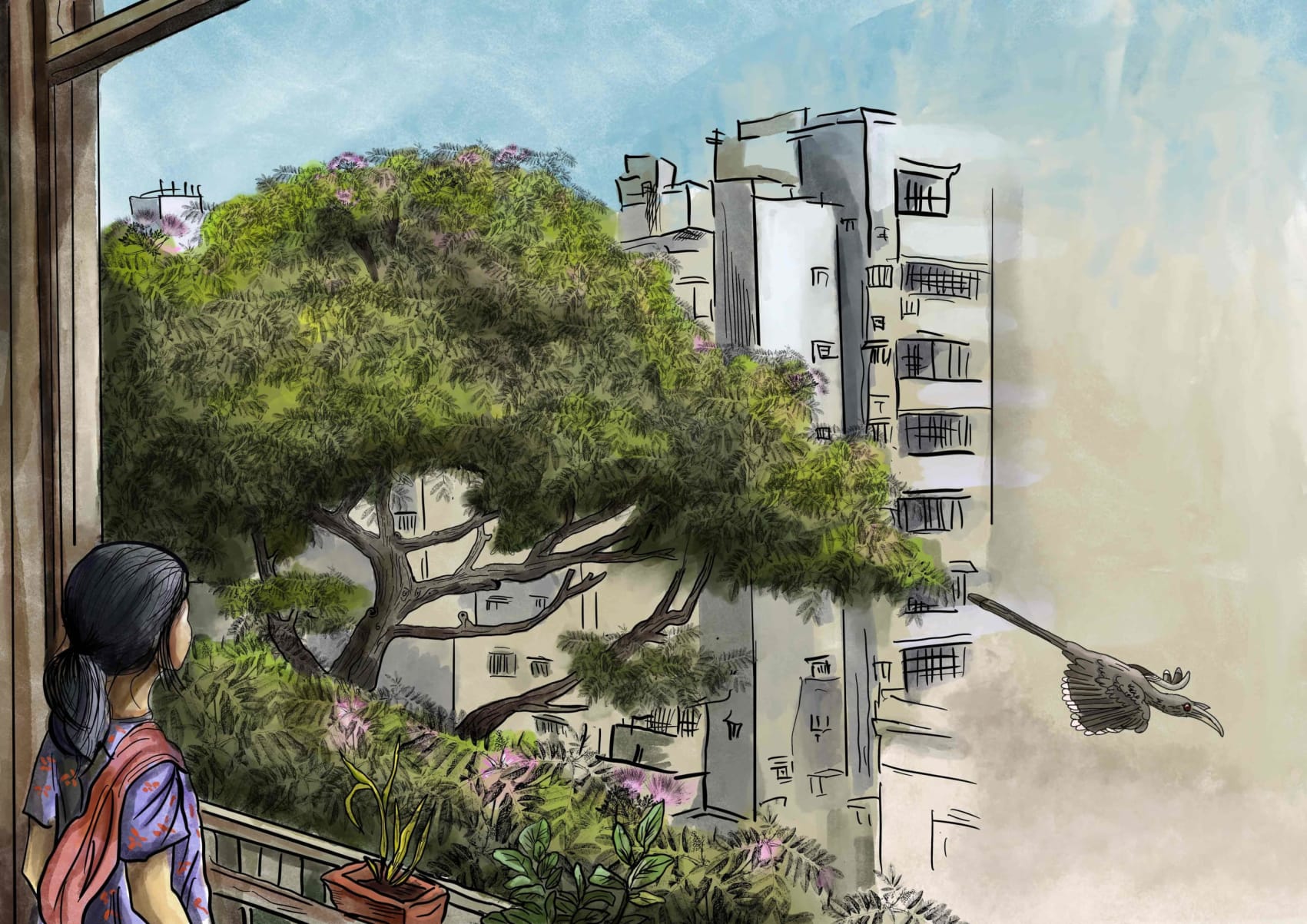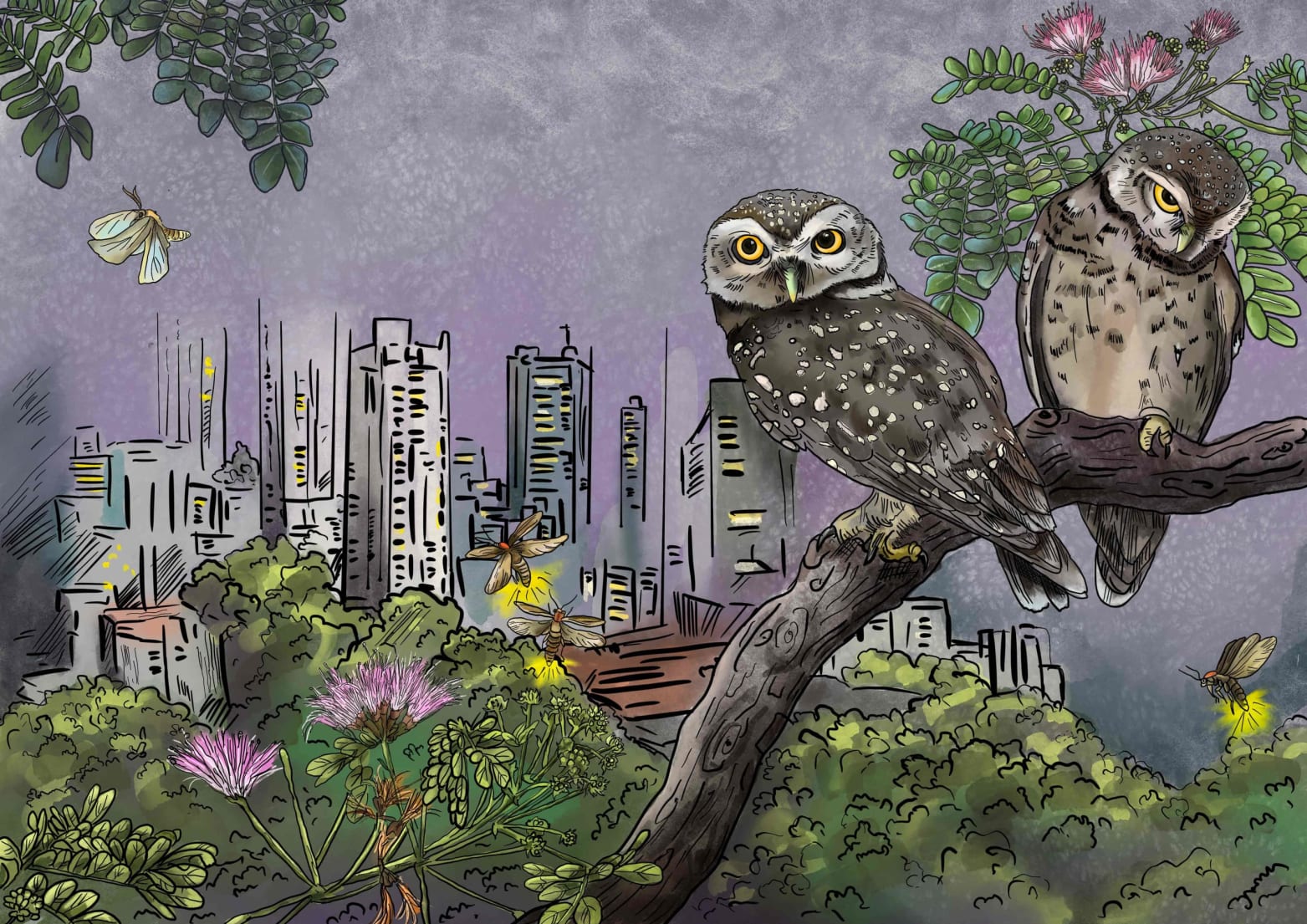 Listen to this article
•
15:34 min
Listen to this article
•
15:34 min
No one quite knows exactly how the rain tree got its name. Some say that on rainy days, the leaves of the tree fold in a way that lets raindrops pass through like a sieve. Others say it is because the tree is reminiscent of an umbrella, with its broad, sweeping canopy. Still others mention the carpet of dew droplets that perpetually seems to be present underfoot. The flower showers of the tree’s pretty magenta and white blooms get bandied about. And some folks altogether prefer another of the numerous names the tree is known by, like monkeypod tree.
The name does not matter. Nor does the fact that the rain tree outside my window is an immigrant in Mumbai, much like I am. Their ancestors may have come from lands farther away, even from the other side of the world, but rain trees or monkey pod trees have become naturalised in these parts. Fixtures of a dynamic city, each tree supports more individuals than a skyscraper full of people.
I started to truly pay attention to one rain tree in particular, its numerous inhabitants, and innumerable visitors, many months after moving into the Mumbai apartment I call home. In the whirlwind of work and the bustle, it was altogether easy to develop an illness more common than the flu in us urban dwellers. Tree blindness. In hindsight, I am quite sheepish about admitting how long it took me to register the towering structure with a canopy as wide as our apartment complex as a living, breathing, looming presence. It went beyond simply taking trees for granted. I completely missed noticing this striking neighbour, and a popular one at that. Some five storeys tall and almost as wide, it was a long-standing and upstanding member of the community, both human and non-human.
It took months of being bedridden at home while I recuperated from cancer treatment for me to notice the unmissable megastructure right outside. I could see the tree from nearly every room, in addition to privileged and prime viewing from my balcony. However, the sense that first brought the tree into the foreground of my clouded mind really was not sight, but hearing. As I lay in bed during treatment, battle weary from fighting actual and invisible inner demons and malignancies, I started hearing the metronomic call of the coppersmith barbet.
A few days into listening and being lulled into a peaceful slumber by the rhythmic rock of the barbet, I tried to find the eye-catchingly colourful bird, unmistakably vocal, and yet hiding-in-plain-sight. And then I saw the blurry and amorphous tree on which the barbet was perched, bobbing out of a picture book of a cavity, entering the periphery of my consciousness, finally registering and taking root in the spongy, tangled recesses of my foggy mind. The rain tree slowly came into focus, bringing sharp relief and clarity, drawing me into a definite present, grounding and rooting me away from a painful past and a hazy, uncertain future.

It was not easy being homebound after years of the itinerant life that I had embraced. But slowing down made me privy to the goings-on of at least one rain tree at any given time. That barbet’s tree made me notice that nearly every window of the house had a view of a rain tree. And each window sucked me into a gripping operatic natural saga unfolding, which was as enthralling as it was entertaining. Eavesdropping came more naturally than I would like to admit. The barbet-dominated afternoons would erupt raucously into the early evening cacophony of children playing and snippets of conversations on devices, which mingled with the jostling of mynas, the trilling of koels, and the parakeet version of musical chairs. This evening chorus would die down to relatively still nights gloriously interrupted by spotted owlets calling like cackling banshees, puffy little cottonball cuteness that would unfailingly evoke a smile, no matter how crabby I felt.
In the years since, whenever I was stuck at home and wracked with loneliness, such as during the long pandemic months, I had but to look out of a window to know I was not alone. The rain tree from my bedroom window had more residents and visitors than I could keep up with. The rain tree, as it turns out, was quite the happening spot, with numerous visitors of the furry, feathered, and flitty kind dropping in. Some of these neighbours were a fun watch, especially during those social distancing days when the most interesting thing was watching sourdough starters bloom. Others would torment me, causing havoc in my little balcony garden, keeping me on my toes, thinking of strategies and battle plans. It is all par for the course. A day in the exciting urban jungle many of us call home, with neighbours both gregarious and grouchy coexisting. Amicable days of minding one’s own business, interspersed with nosy interference from some, borrowing things never again to be seen, petty thievery, quarrels breaking out, talking over each other, and the sort of everyday interactions that are as routine as commuting to work during the Mumbai monsoon.
It was always exciting when the langurs came a-visiting. The low booming calls invariably bring anticipation about a potential leopard in the vicinity, especially after sundown. When there is plenty of daylight, it is a study in contrast to watch the rain tree become a playground for the reserved and dignified langurs and the rambunctious mischiefmongers masquerading as macaques. The langur families evoked a calm, blissful, being-at-a-retreat energy. In contrast, the boisterous macaques brought a madcap carnival vigour that tacked on a threat of barging into homes, windowsills, balconies, and gardens, making merry while they made a mess.

There were pesky rodents with bushy tails whose life’s primary purpose seemed to be to bewilder new birders into trying to identify their bird-like call; face-palming when the earworm proved to be a palm squirrel. Mongooses would occasionally rummage through the base, hidden in the understorey and shrubbery, looking shifty and surreptitious for no reason whatsoever. Small monitor lizards would clamber up the long trunk, looking regal, like miniature Komodo dragons.
A pair of grey hornbills would make a pitstop each evening before heading to their roosts for the night. Paradise flycatchers would transit at teatime, the festive tail feathers of the males dangling like crepe paper streamers. The flying festoon ribbons of their courtship displays would liven up my day. Flameback woodpeckers would circle the tree bark like bejewelled corkscrews, and striking golden orioles gleamed and glinted in the dappled shadowplay of sunshine and shade. Oriental magpie robins, in dapper feather tuxedos, would flit about, making no secret of their presence, sharing their vast repertoire of birdsongs with the ease of professional performers. Tailorbirds would quietly build nests on the rain tree’s branches, while sunbirds bobbed around the pretty-in-pink petals. Coucals and jungle babblers would hop about in the shady undergrowth of the tree. The former were solitary, like a dignified grandpa out on a walk, and the latter in gregarious gangs, living up to their sobriquet, the “seven sisters”. Dusky crag martins would fly near the rarefied upper canopy, whizzing around buildings, roosting in parking lot crevices and ledges, adapting to the makeshift mountains of concrete, having transitioned from the craggy peaks of their ancestors. Once in a while, I would spot a cattle egret or a black-crowned night heron perched ludicrously on a branch, looking like an obvious tourist. On quiet windless nights with nary a breeze, I would stop in my tracks to hear the call of a barn owl, heading to the nearest window to catch a glimpse of a creamy white face shimmering in the moonlight, silhouetted on a branch, near a hollow in the rain tree’s trunk.
The visitors to the rain tree would change with the seasons, an annual turnover as old as time. As the monsoon assaulted the senses with petrichor, minuscule magic lanterns — fireflies — lit up the rain tree, like tiny torches for the toads and little lamps floating above the damp leaf litter. I have seen an assortment of serpents near the tree at different times, including rat snakes, keelbacks, cobras, and vipers, lurking quietly in the tree’s damp base. On rare rainy days when the clouds would pause the downpour and sunbeams cause rainbows in the recesses, geckos would come out to bask, and butterflies would float seemingly aimlessly at eye level. Ants, bees, bagworms, beetles, cicadas, crickets, centipedes, dragonflies, earthworms, flies, grasshoppers, mosquitoes, moths, scorpions and snails — a miniature menagerie of invertebrates sharing space on this single rain tree.
This rain tree, teeming and throbbing with creatures great and small, offered a quiet lesson amidst the entertainment. Even in a claustrophically crowded metropolis like Mumbai, the wild manages to seep through, like a tree taking root through the concrete slabs and crumbling buildings. And every tree becomes an island within this island — providing life and livelihood to diverse fauna. Every tree counts, and I hope everyone has a view of at least one tree at all times. If it happens to be a rain tree, perhaps we can swap notes on tree watching, tragicomic capers, and neighbourhood gossip of the rain tree kind.







